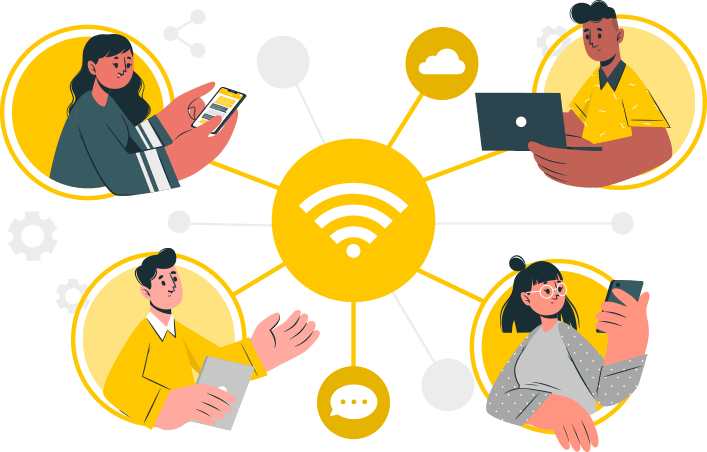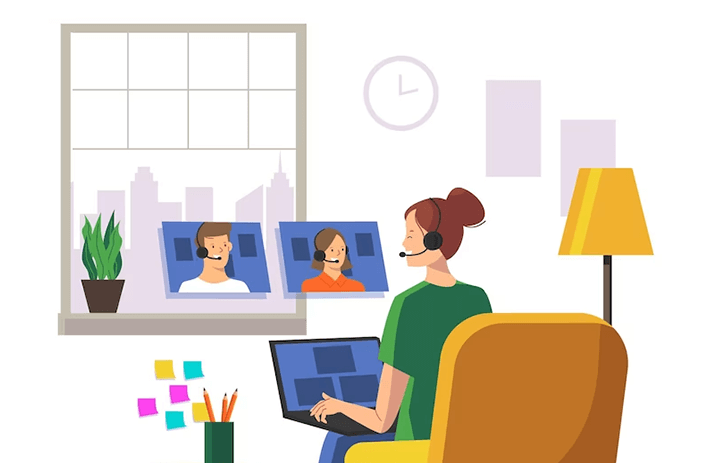
Click the button to start reading
7 Valuable Methods to Improve Group Dynamics
There are consequences to being a feckless leader. Poseidon thought Cassiopeia was an out of touch manager, so he banished her to live forever among the stars.
Plus, teams without strong dynamics leave employees feeling isolated and disconnected. Work performance suffers.
Yet, as any manager knows, inspiring a team is no cinch. Do you realize that even the time of day you send messages to your team affects their work habits and drive?
Building a team who finishes one another’s sentences, hums away like a well-oiled machine, and always has each other’s back may seem out of reach.
But in fact, it’s easier than you think–even for remote teams.
Wanna know the tricks to making your team tick? Here are seven points to consider when you want to improve team dynamics.
1. Evaluate Feedback Transparently
Gathering employee feedback after meetings and completed projects, as we know, is an important practice.
But making the feedback constructive depends on how it’s gathered and evaluated. Here are two suggestions.
Future-Focused Feedback
After a big project, it’s normal for team members to use feedback to air all their grievances toward individuals and to focus on things that went wrong.
This sort of feedback helps only to the extent that it determines how the team works together going forward.
By having everyone begin feedback with phrases like “In the future, I think we…” and “Going forward we should…” and “Next time we should…” keeps the criticism future-focused.
This technique also makes the feedback framed around the group as a whole, rather than individuals.
Post-Evaluation Sessions
Feedback that’s gathered and then discussed only amongst top-tier employees isn’t transparent.
In order to value everyone’s contribution to the process, it’s important that feedback be coalesced into a single document. Then, it can be disbursed and reviewed openly amongst the entire team.
By holding a meeting where the agenda is solution-oriented, such as “Use Feedback to Plan Future Project,” the momentum is geared toward the next phase.
An open place where everyone can contribute and air grievances builds strong team cohesion and psychological safety within the base.

2. Design the Workplace Strategically
Fostering employee well-being is critical to creating a culture where employees thrive. A well-designed office plays a central role in this. When a team has a work environment that’s comfortable and energizing, people want to show up and give their best.
Consider these points when designing a workplace layout.
Create Atmosphere With Acoustics
The acoustics in a space really affect its overall feel. Low ceilings and deep carpets give the space a cozy feel. High ceilings and wood floors make the space open and freer, yet a little more austere.
Separate Group Areas From Hunker-Down Spaces
Most days, people need to work both collaboratively and in a quiet, focused setting.
When a workplace has a clear demarcation between areas where collaborative work takes place, and where focused work is respected, it’s much easier for employees to switch between roles.
While there are no right and wrong choices about office design, it’s important to remember that a workspace reflects the company’s culture. A well-defined culture provides direction toward finding a design that fosters strong team dynamics.

3. Choose Tools Wisely
Do you have a favorite browser? What makes you choose it over another: is it the bookmarks tab? Or the navigation buttons?
Just like browsers, every tool has special features to make it unique. When choosing the messaging, email and video conferencing tools to use in your business, it’s important to research everything that is out there, and consider their pros and cons.
An excellent video messaging app, for example, provides a remote team with a great way to communicate verbally throughout the day. This allows them to pick up non-verbal communication like facial cues, expressions, and tone, which are all lost with text messaging tools.
That is to say, picking good tools plays a huge role in the quality of team communication.
It’s easy for teams to get into fixed habits with certain tools. However, if you’ve done a lot of internal and external research, and think a certain tool is right for your team, don’t be shy about implementing it.
As with anything new, there will be hiccups and start-up pains. But if the tool really improves the way a group interacts, you can’t lose in the long run.

4. Model the Culture
Way more than anything written into the company handbook, a manager’s behavior influences team dynamics. As though fearlessly following a drum major, the employees march in sync after the team leader.
Imbue Work Culture
Every manager needs a strong understanding of company work culture, and to reflect it in their behavior.
For example, if a company has a policy to maintain work-life balance for employees, then managers might consistently block off times in their schedule when they’re unavailable to work. This demonstrates to everyone else in the office that they’re free to do likewise.
Communicate Within Scheduled Hours
In a similar vein, when a manager sends out messages at all hours of the morning and night, employees also feel pressured to be “on” at all times.
In order to create a dynamic where a team is energized and ready to work, it’s best to confine messages and other communication to regular business hours. Working non-stop quickly makes a team burn out.
Get the Ball Rolling
In order to create a cohesive, united team, the manager needs to not only suggest team activities, but also to model and participate in them.
For example, let’s say a manager sets up a virtual break room on a video conference platform. In order to make it an active place to build rapport, the manager needs to make a practice of regularly going into the “break room” and shooting the breeze with whomever is around.

5. Learn From the Data
In order to improve group dynamics, a leader needs to understand the current communication patterns of the group.
Particularly in remote work environments, closely analyzing data from the company’s communication tools provides significant clues about areas to improve.
Here are a few things to focus on.
Boost Interaction Within Teams
Look closely at the kind of interaction that takes place within different departments.
For the sake of company transparency, it’s important for every team to be on the same page and to know about significant achievements within the company.
If this is an area that’s weak, try setting up some company-wide communication processes, such as an internal blog.
Utilize Popular Tools on the Team
Have you ever bought a new and improved version of something, only to discover that you preferred the older model?
It’s quite possible that employees use certain tools way more than others, including the out-dated versions.
Closely examine the tools that get the most use, and try to tease out why. Is the tool user-friendly? Maybe some teams prefer video messages over text. Which browsers do people generally use?
Knowing these details allows you to choose the right method when you want to communicate to various departments and individuals. It also provides good information about how the team would adapt to new tools.
Set Clear Work Hours
Fostering work-life balance is integral to creating an energized team. If your team spans several time zones, look closely at which times of day certain employees work.
Setting boundaries and limitations around work expectations during off-hours allows for employees to be “off” and “on” at appropriate times for their zone.
In sum, communication data is invaluable for spotting problems and boosting team dynamics. It’s also useful for planning group activities.

6. Communicate Efficiently
In remote cultures especially, businesses are trending toward increasing the amount of time they spend on calls and in meetings.
Although this is an effort to bridge communication gaps, it leads to work overload, as it makes employees’ calendars completely blocked.
It’s critical, especially in remote work environments, to communicate at least every other day. But it’s also important to make the interaction brief and effective. Here are two ideas.
Only Schedule Meetings that Resolve Problems
The objective of a meeting, in general, is for people to discuss an issue and arrive at a consensus around it.
If you’re wanting to simply disseminate information, then another method, such as email, might work just as well, and save time for everyone.
Run a Tight Meeting
When it is necessary to meet, make sure the meeting is well-planned so everything clips right along.
Have the agenda shared with everyone beforehand, and be sure that anyone who is presenting data or spreadsheets knows about it.
When people’s time is respected, it creates a more satisfied and cooperative team.

7. Gather Informally at Regular Times
It’s so important for teams to spend casual time together. It allows people to get to know each other personally, which increases the empathy and psychological safety within the group. It also allows for new employees to gel with the team.
For remote teams, especially those working across many time zones, this poses a challenge. Here are a few suggestions.
Casual Time Before or After Meetings
Dedicate the ten or fifteen minutes before or after every meeting to casual chats. This allows people to catch up, share cat photos, and develop some rapport.
1:1 Skip Level Chats
In order to create an open culture, it’s important for everyone to interact regularly. Making a habit of upper management meeting 1:1 with team members allows for all sorts of problems and concerns to be addressed.
Virtual Break Room on the Video Conference Platform
As mentioned earlier, having a “virtual break room” allows employees to shoot the breeze with one another during the day, when they need a little respite from the daily grind.
Attitude Adjustment Happy Hour
Whether real or in-person, making a weekly commitment to fellowship time definitely increases team enthusiasm.
It’s so important for everyone to let their hair down and celebrate everything they accomplished at the end of a long week.
Conclusion
Listening to and getting to know your own team is key to increasing the dynamics within the group.
Every group of individuals has different methods and preferences in how they communicate.
Just by making a few tweaks, you can create a team dynamic that lands among the stars!
















